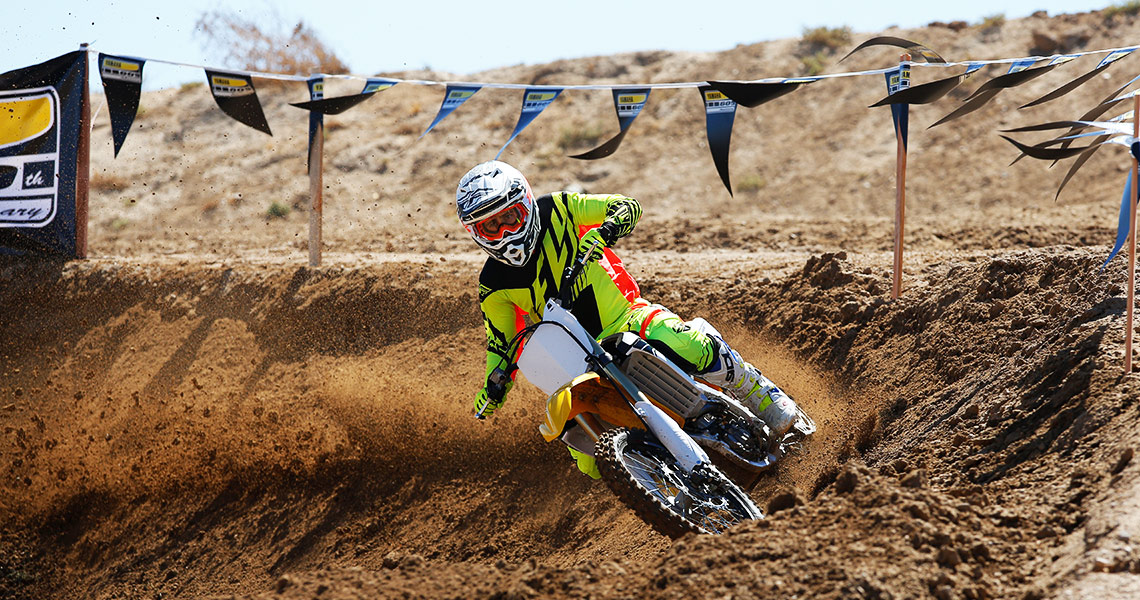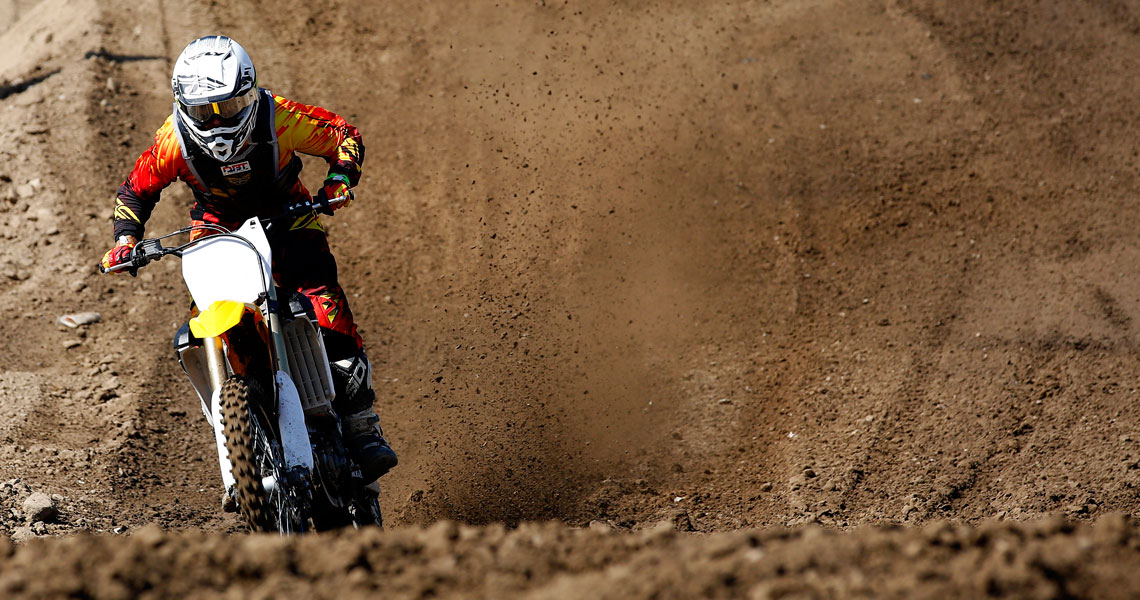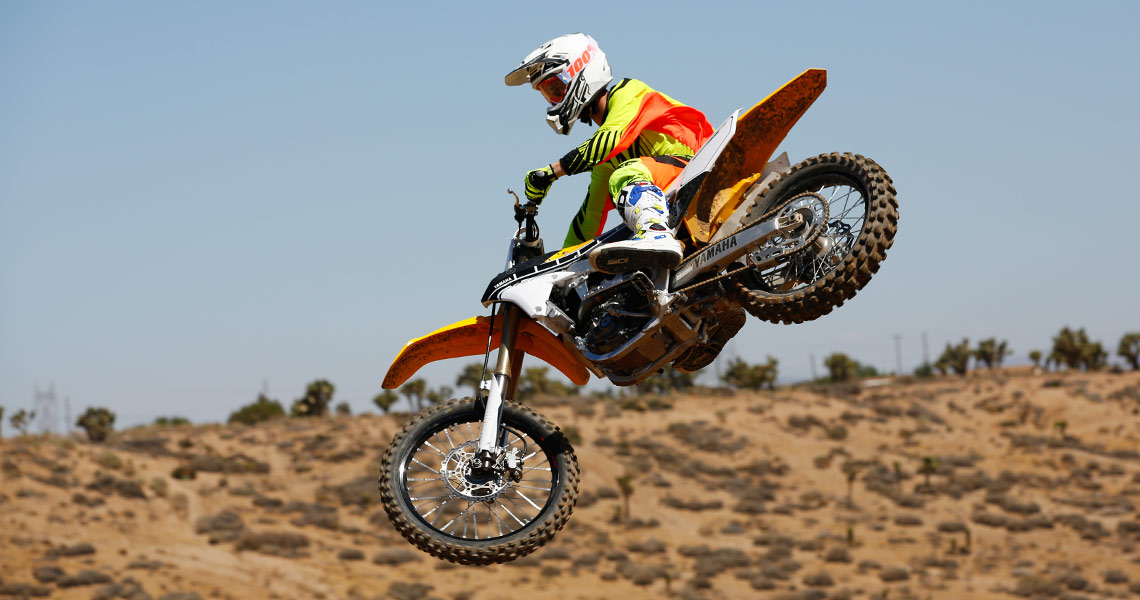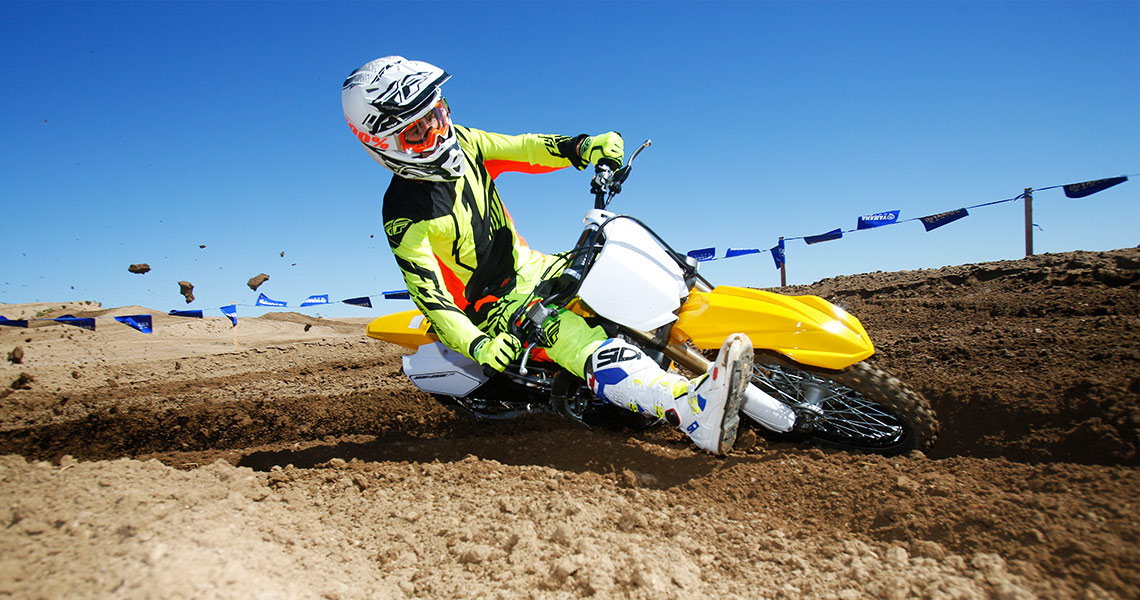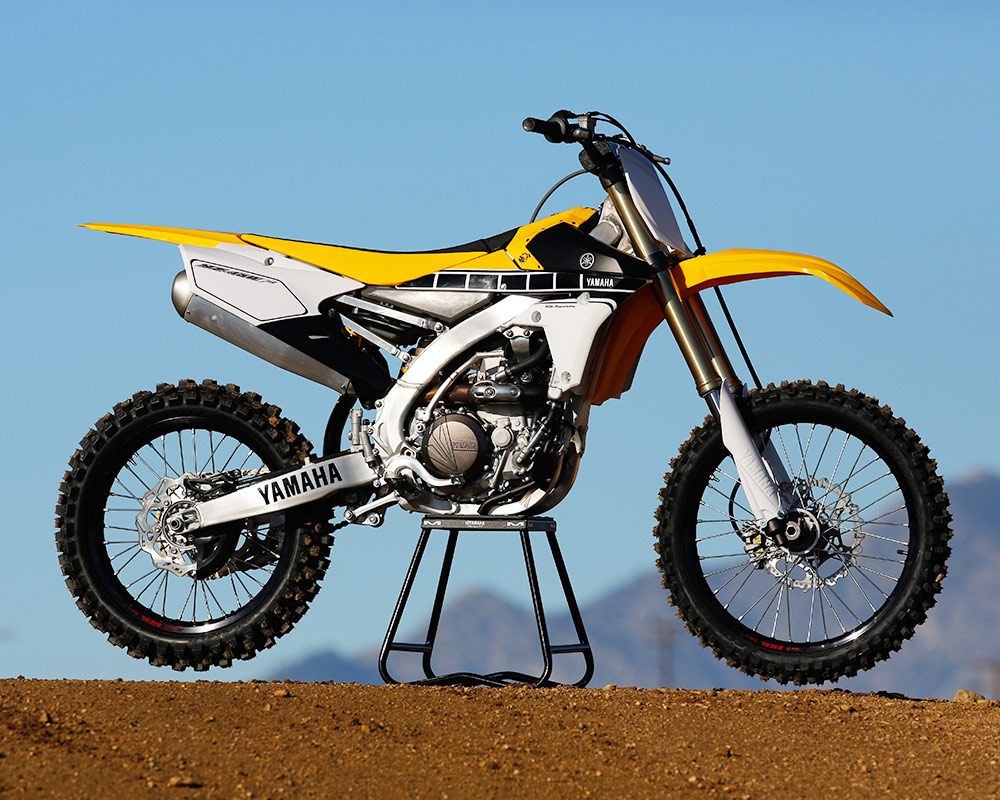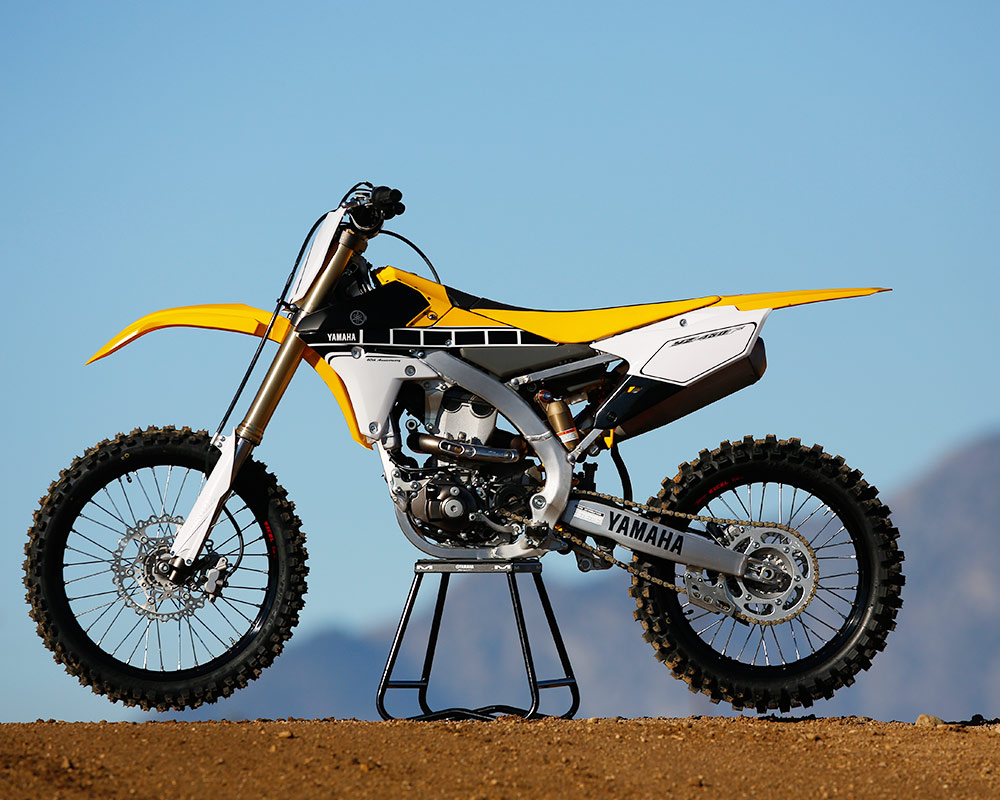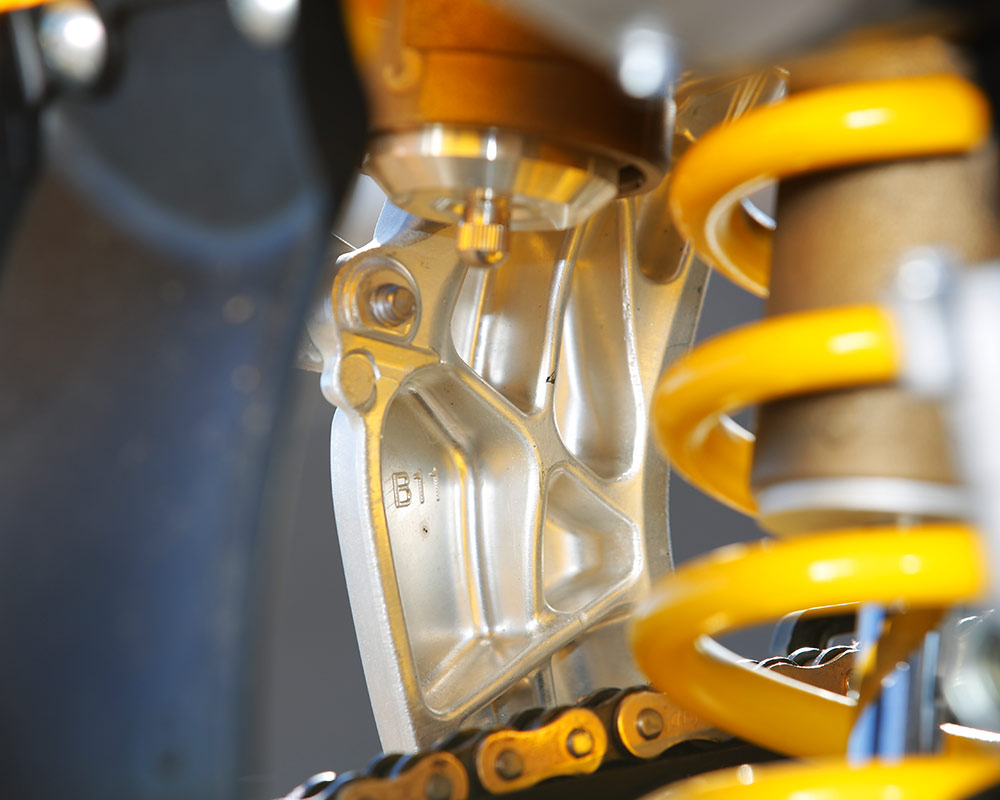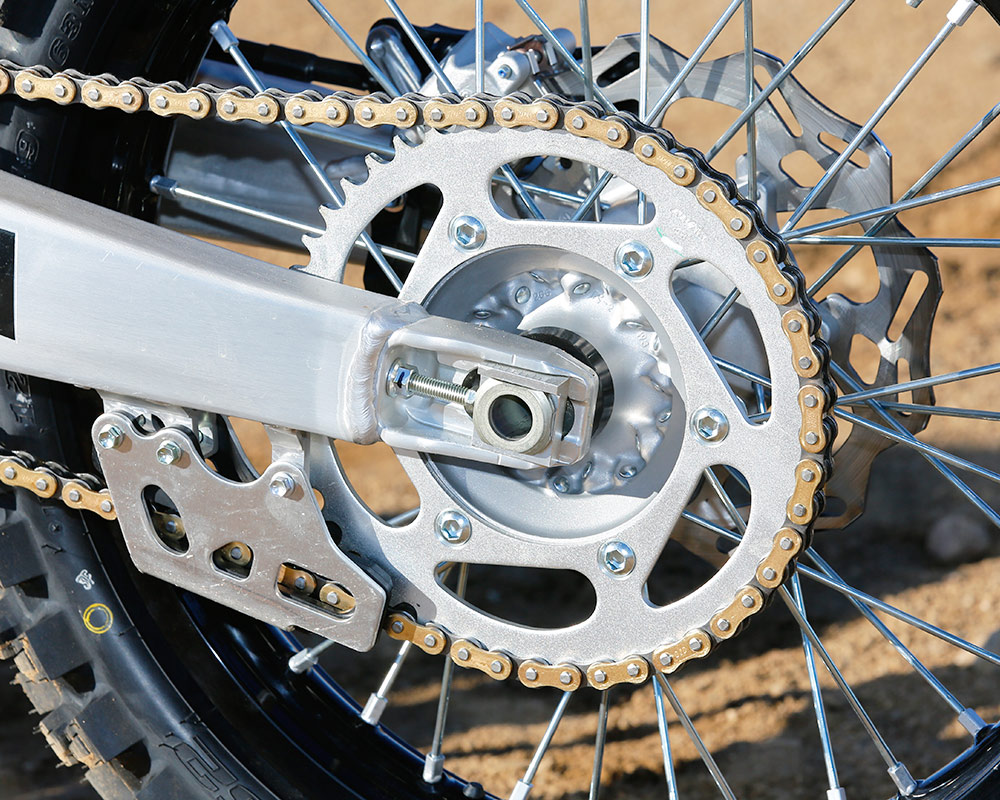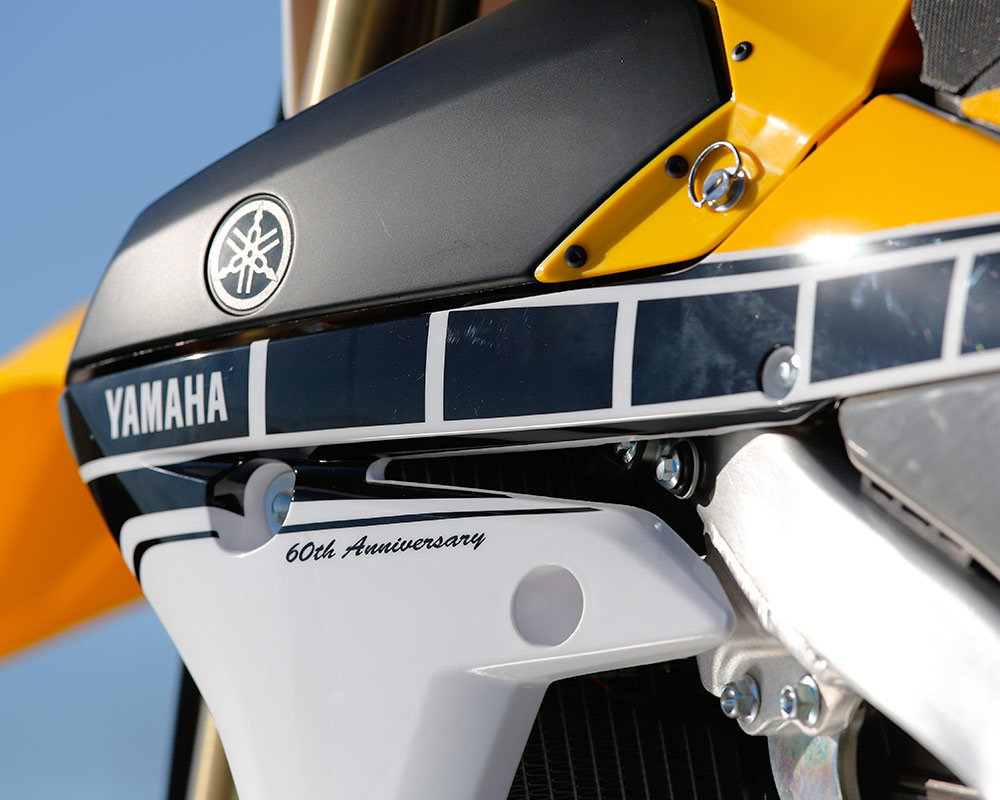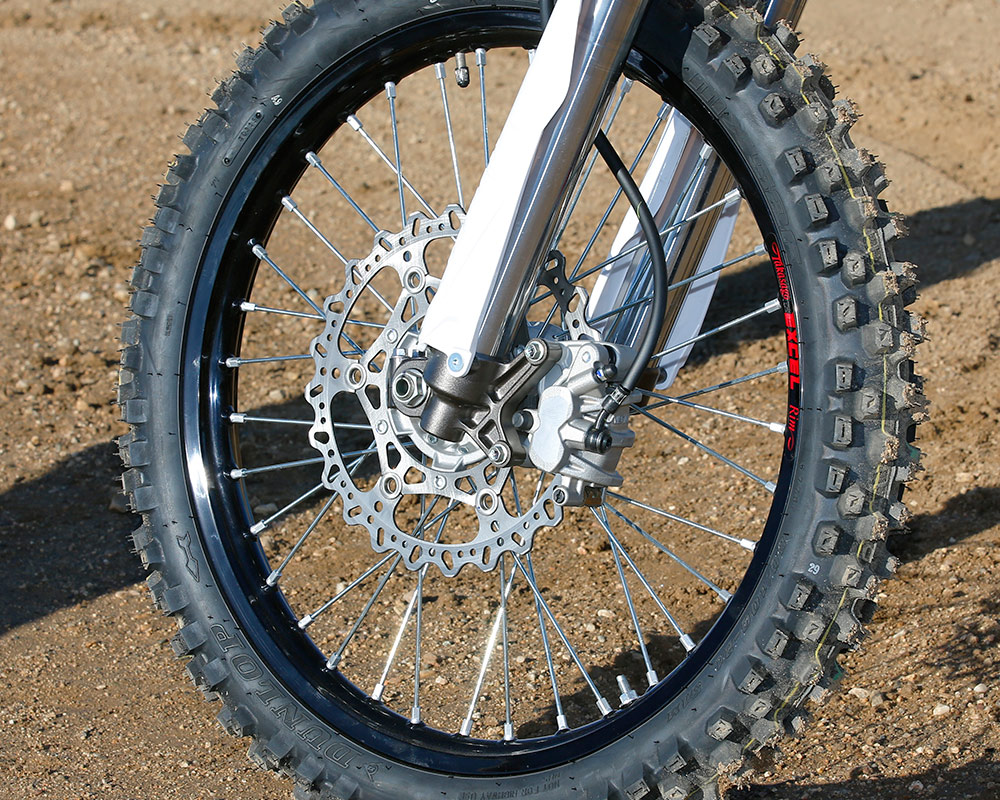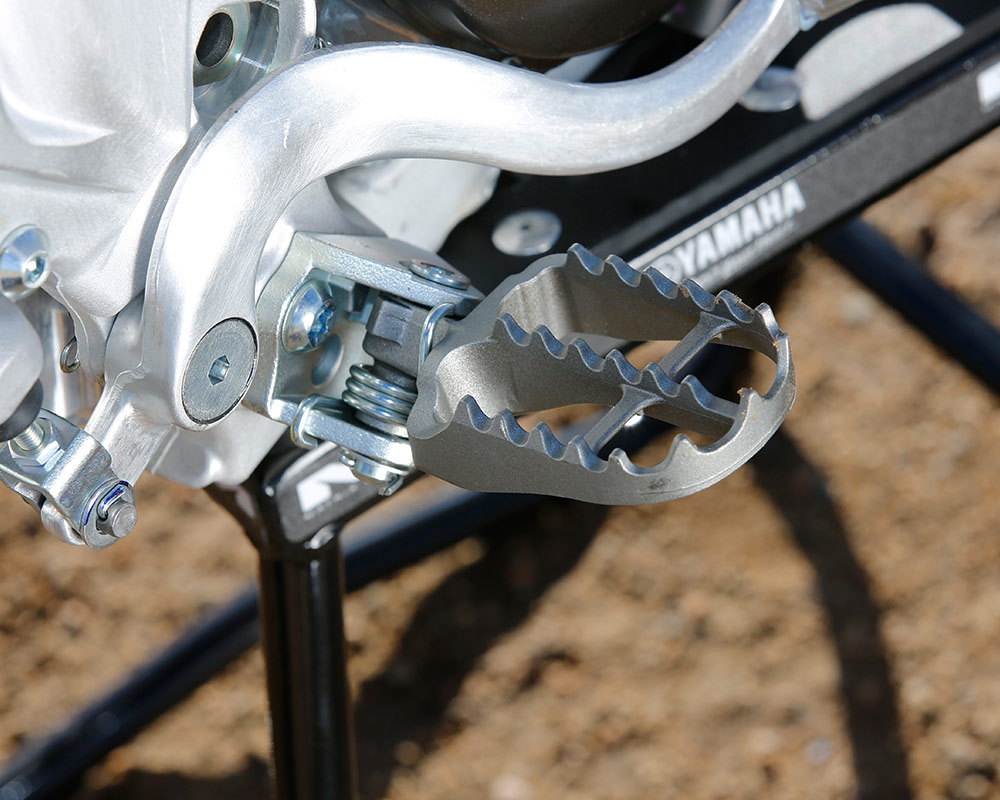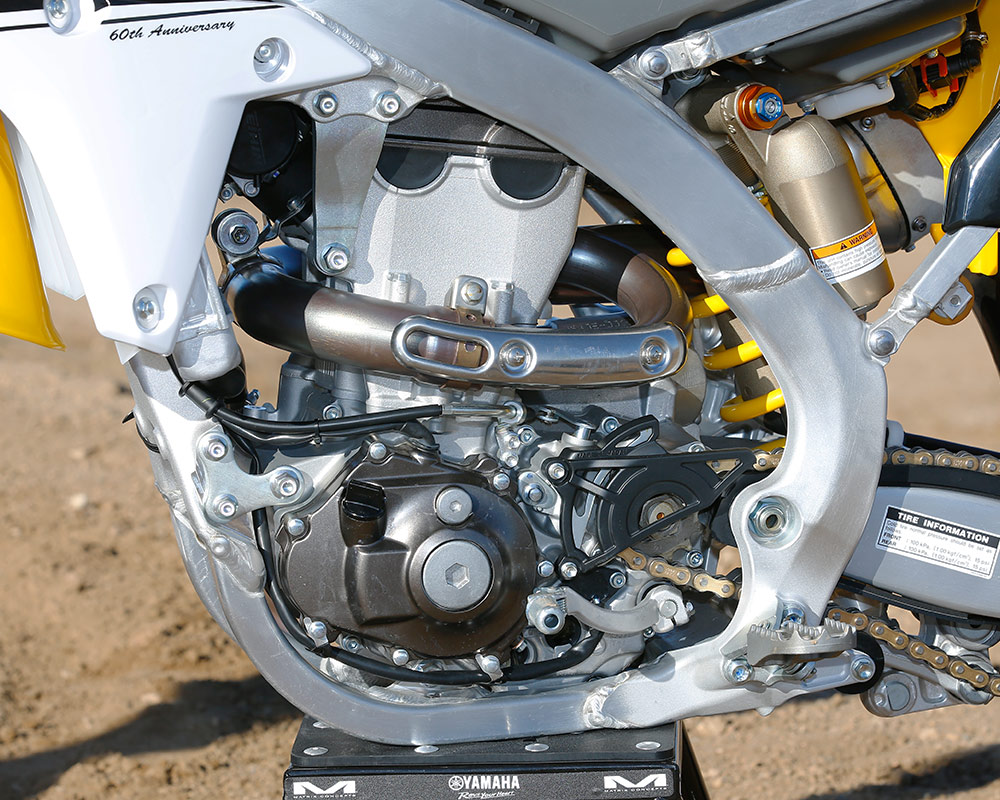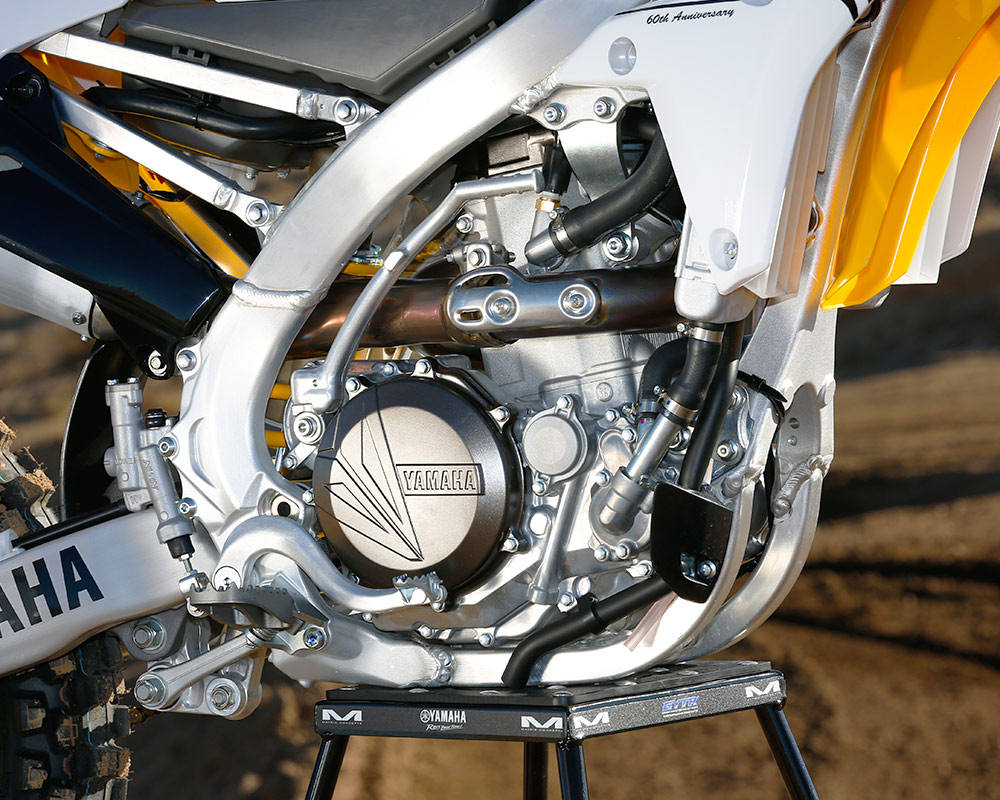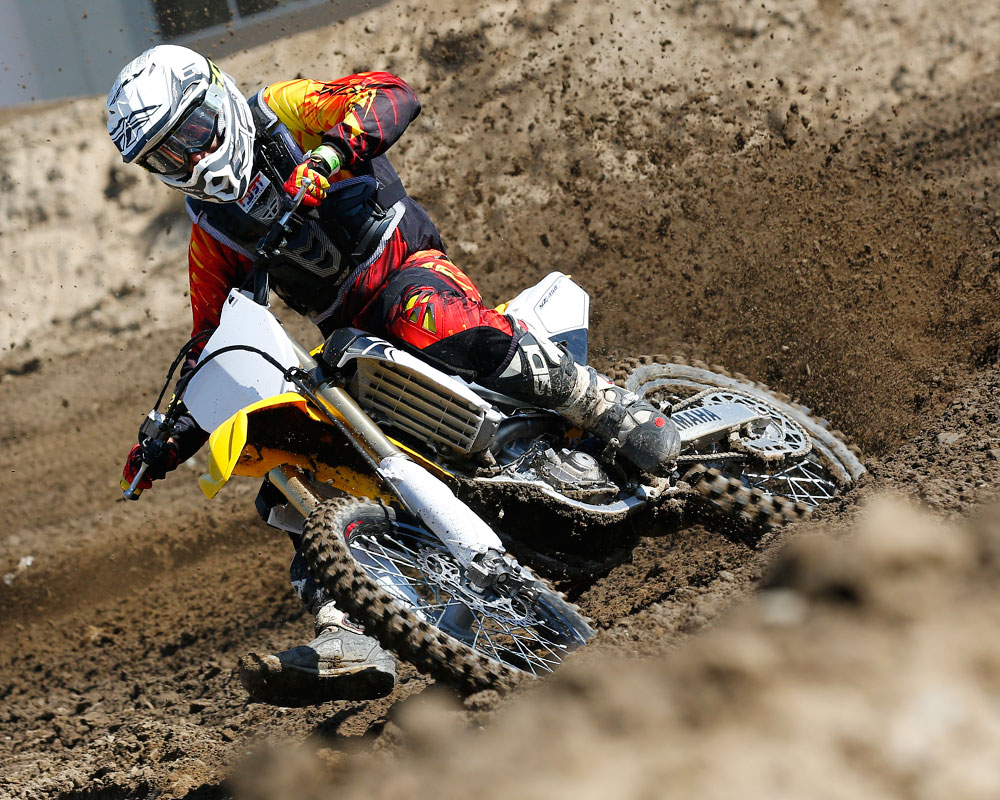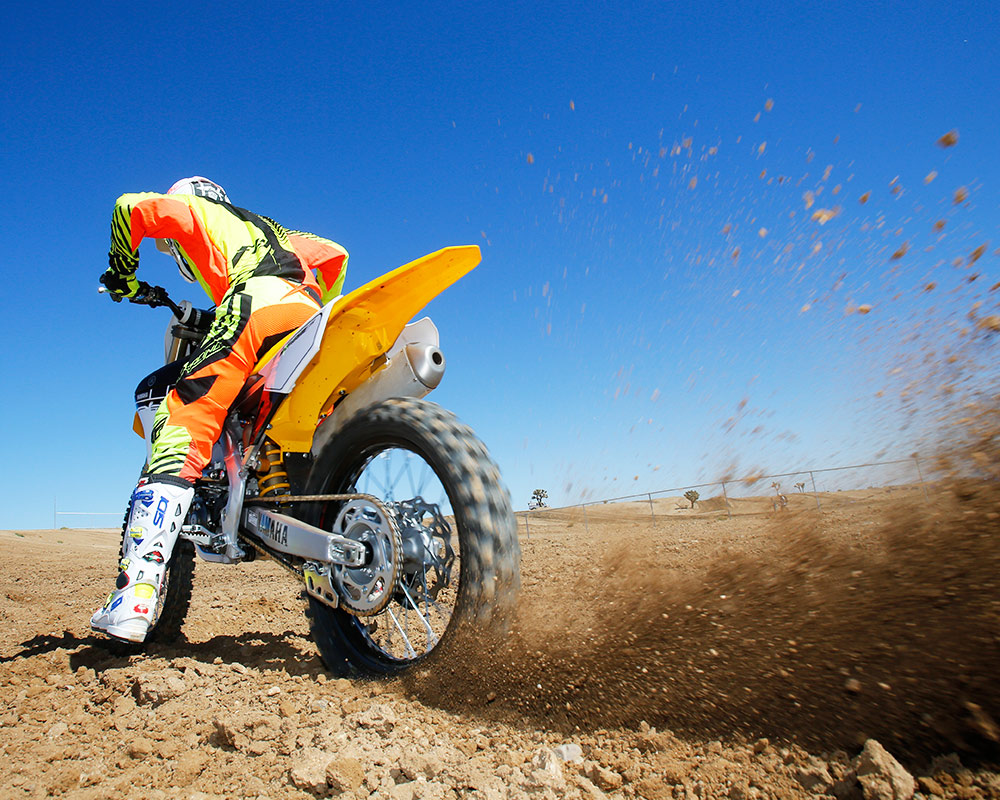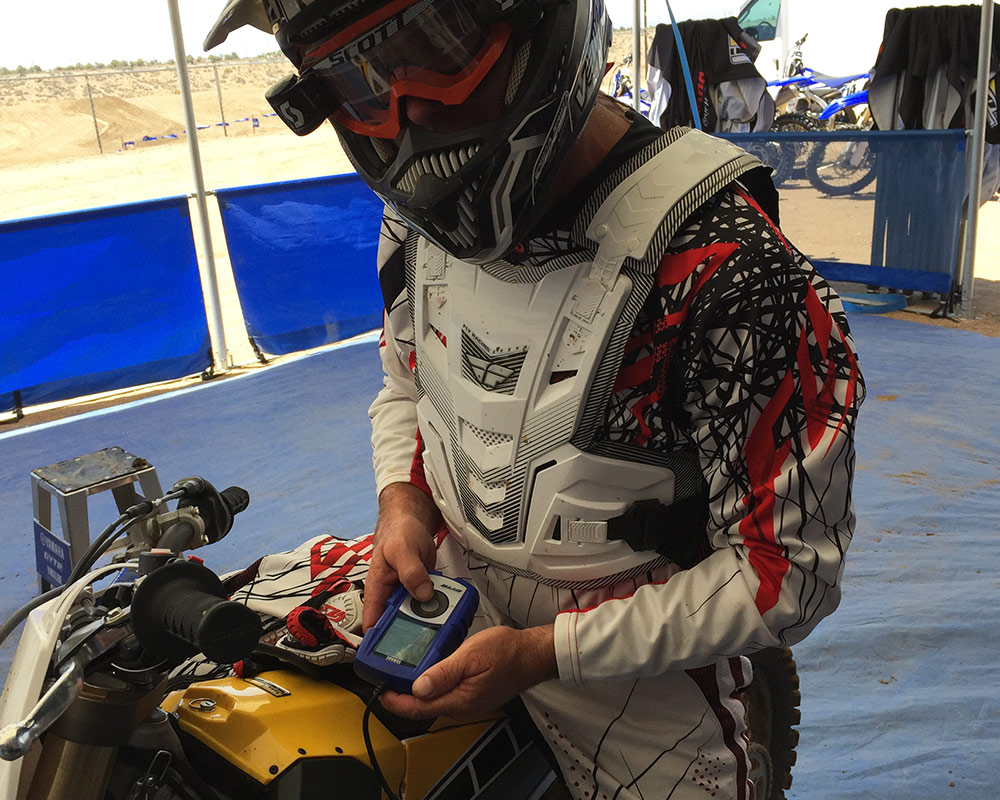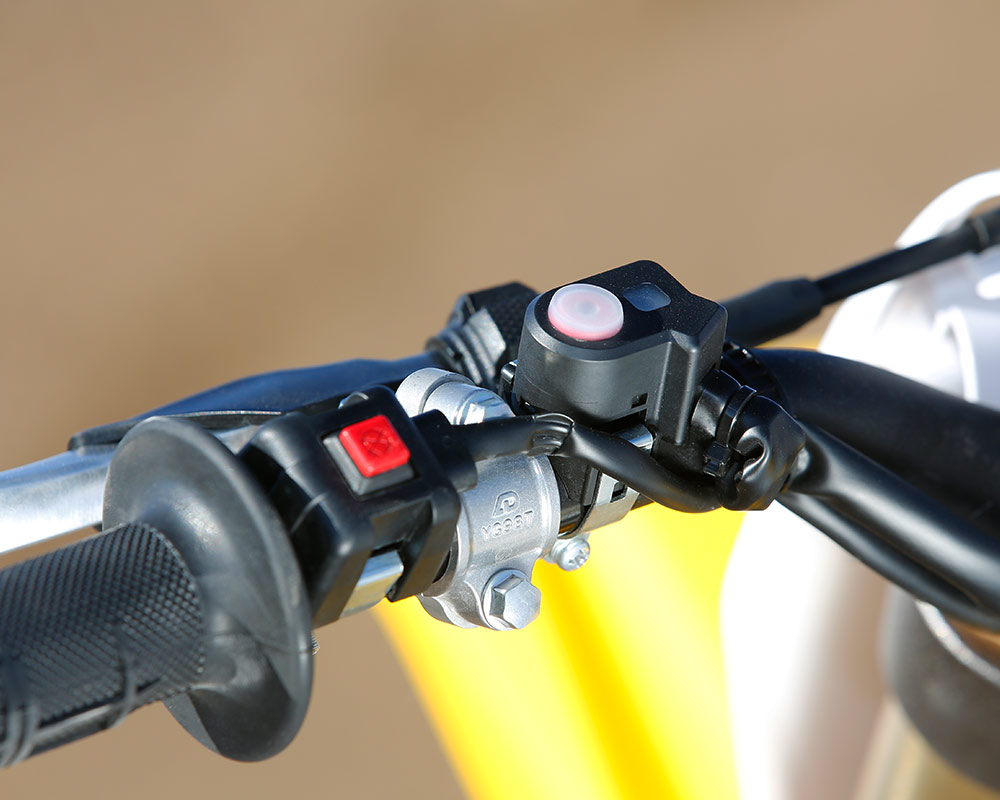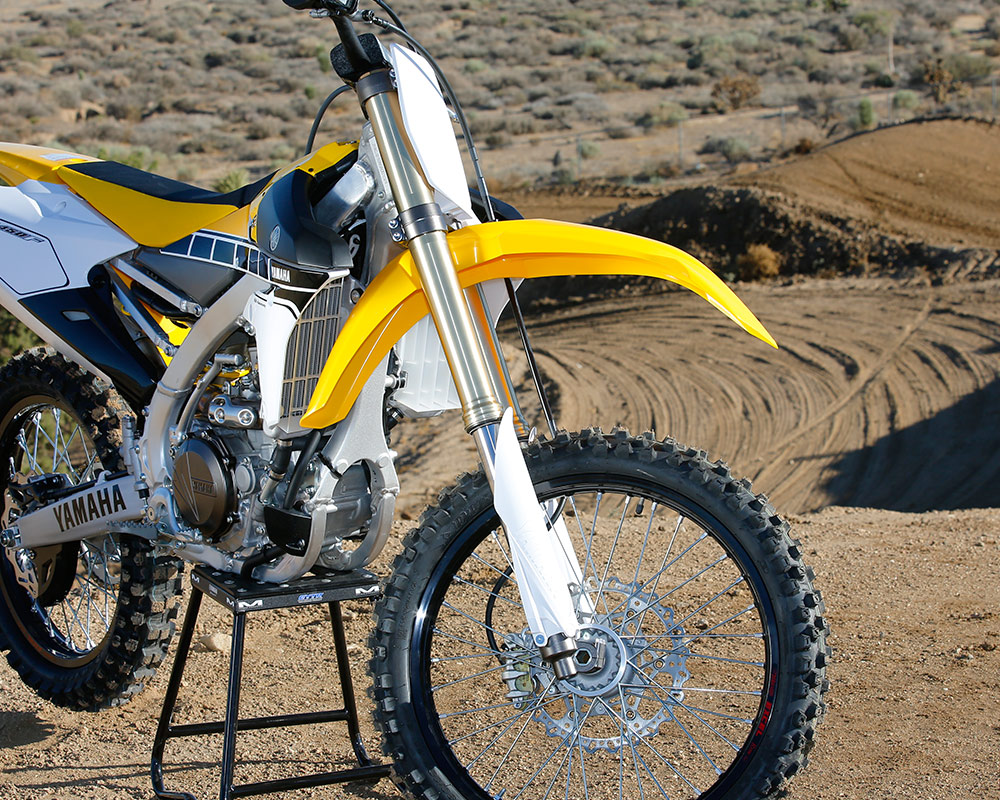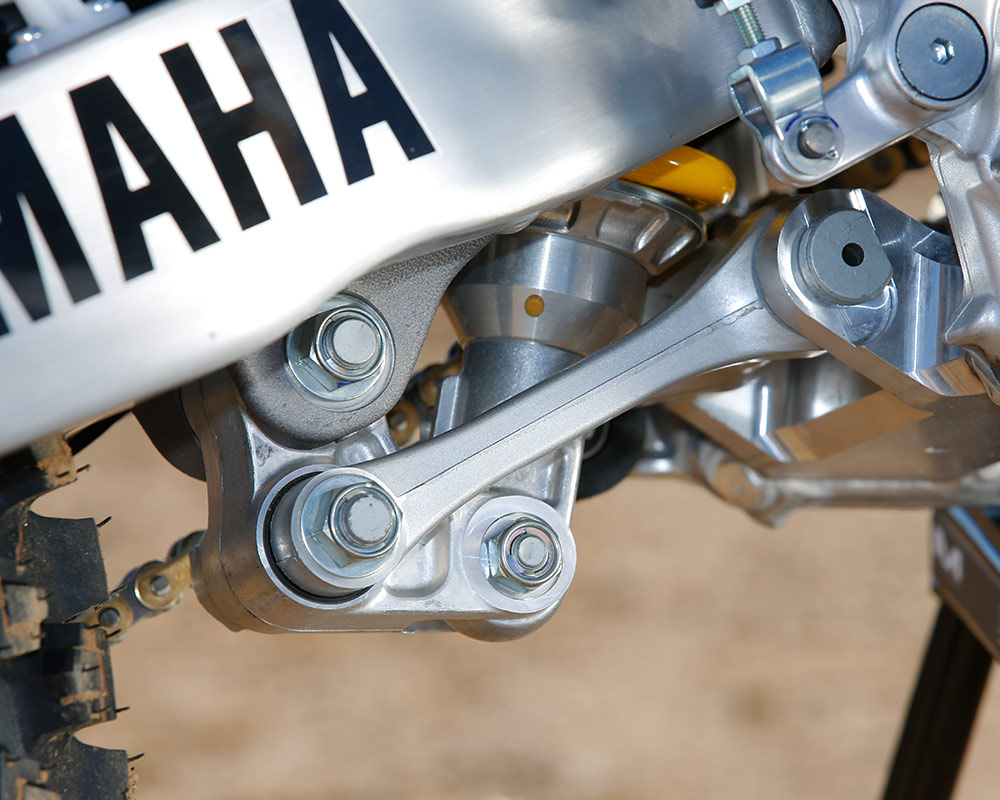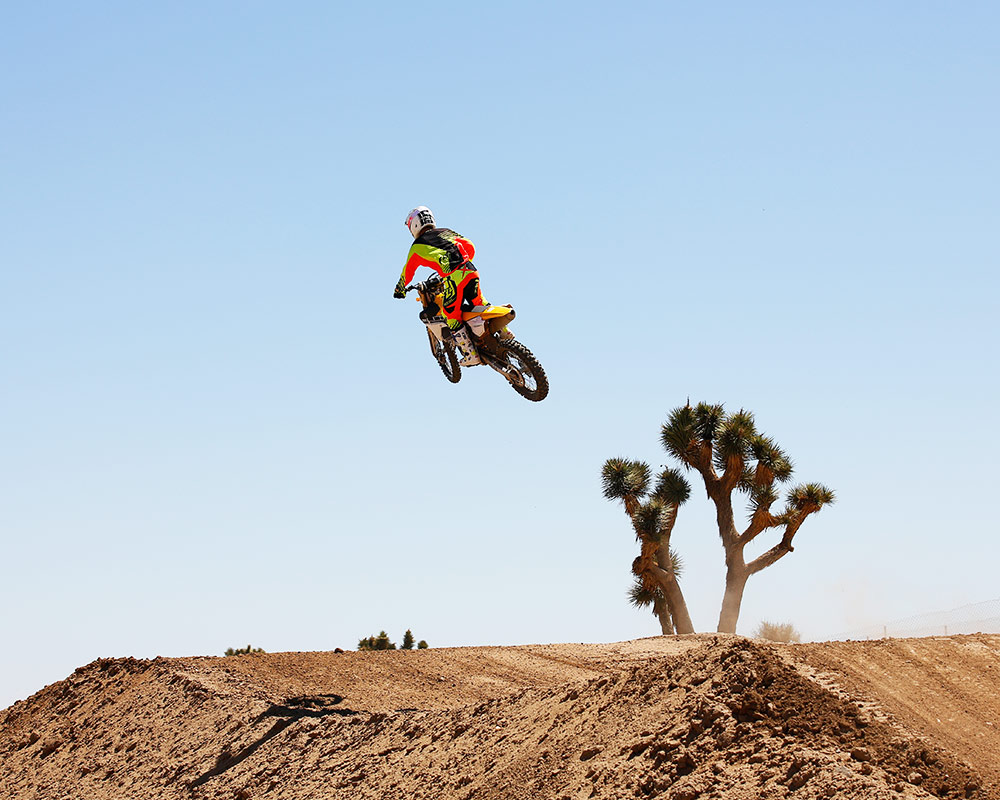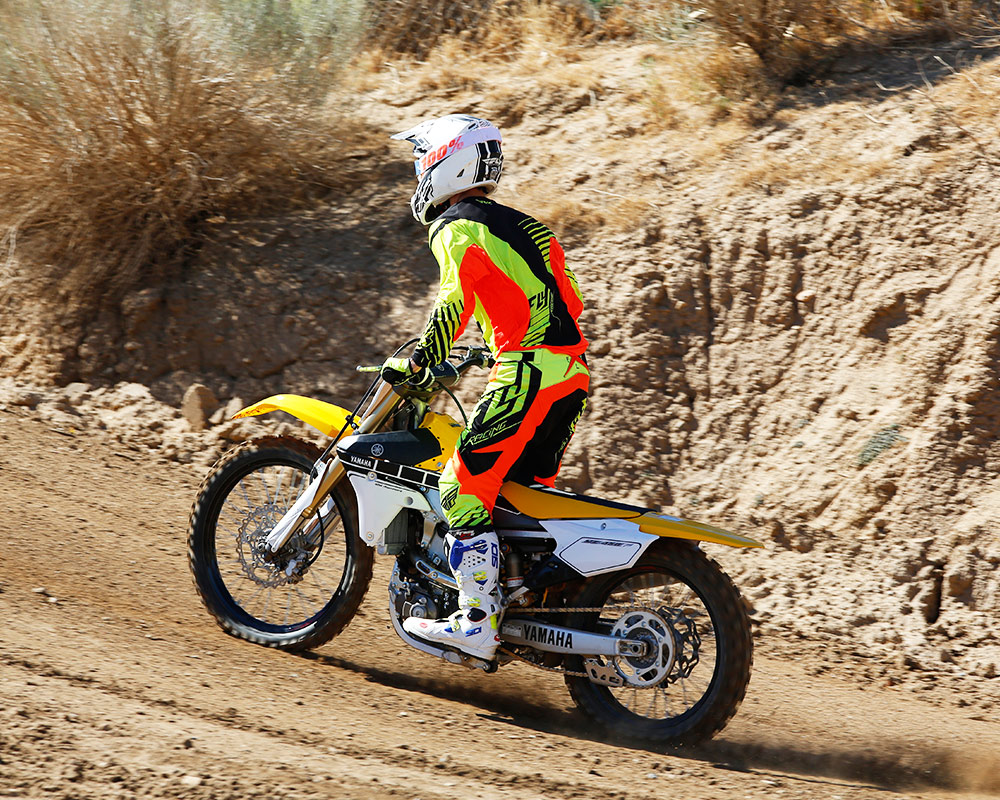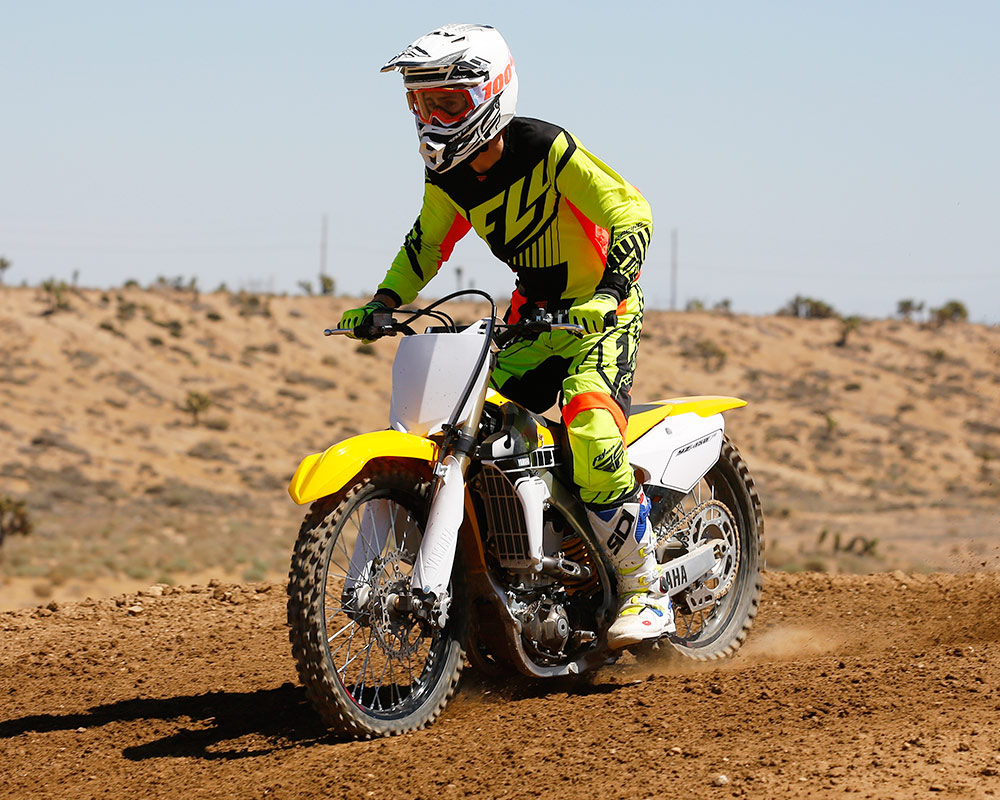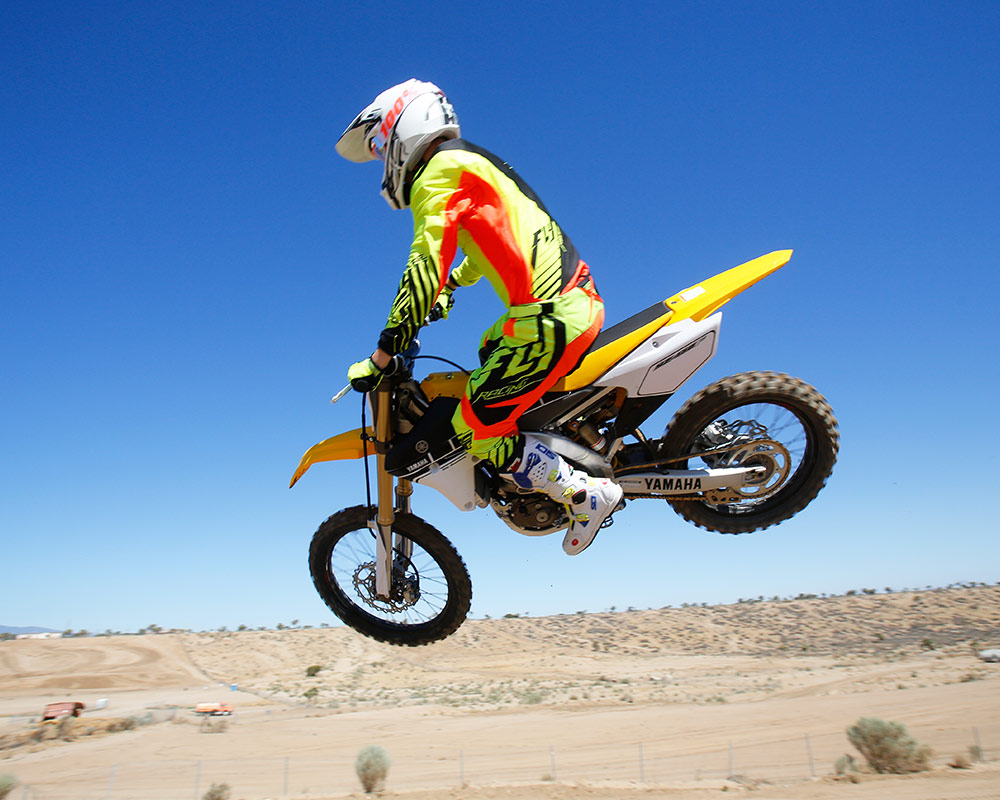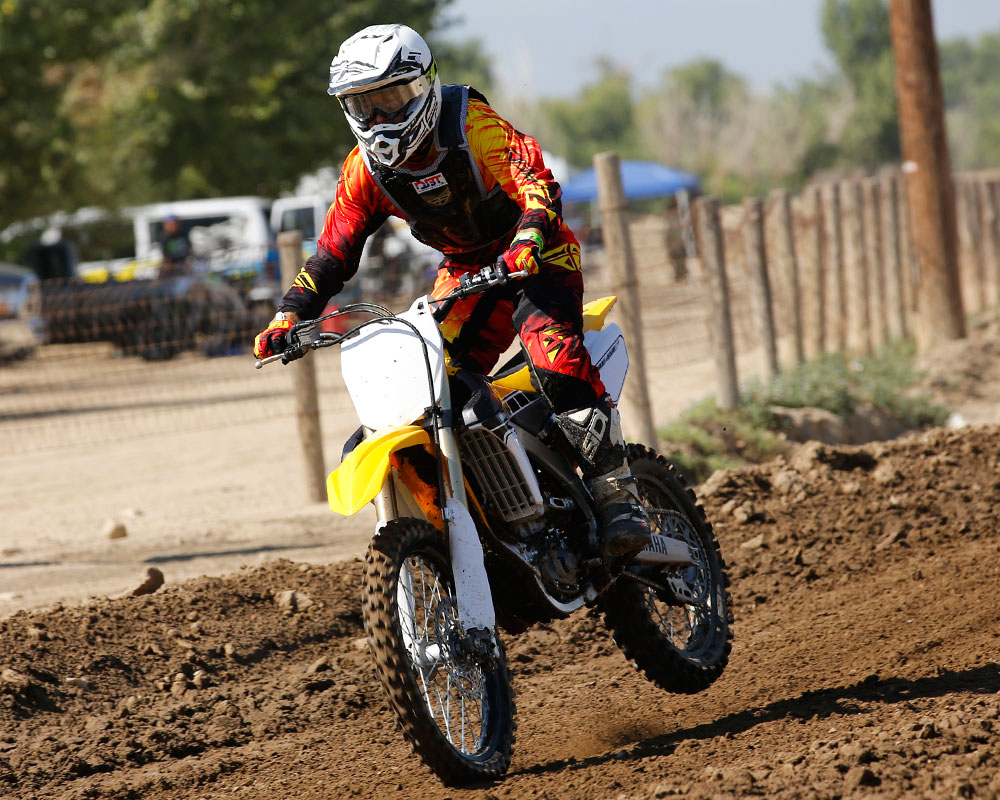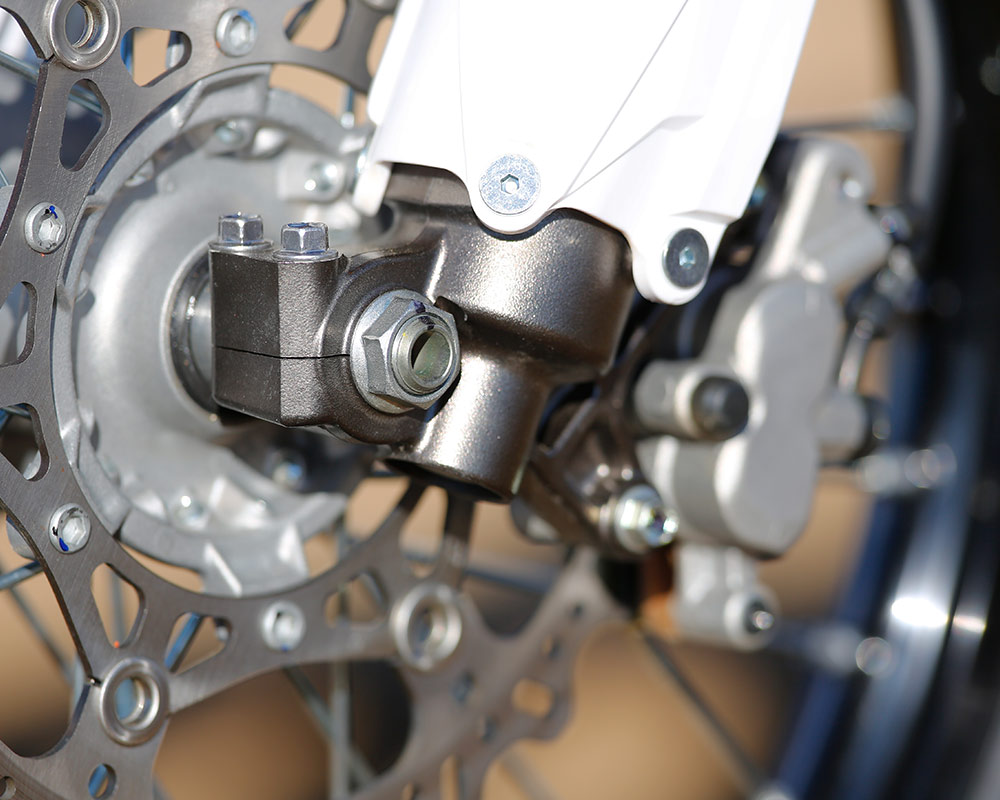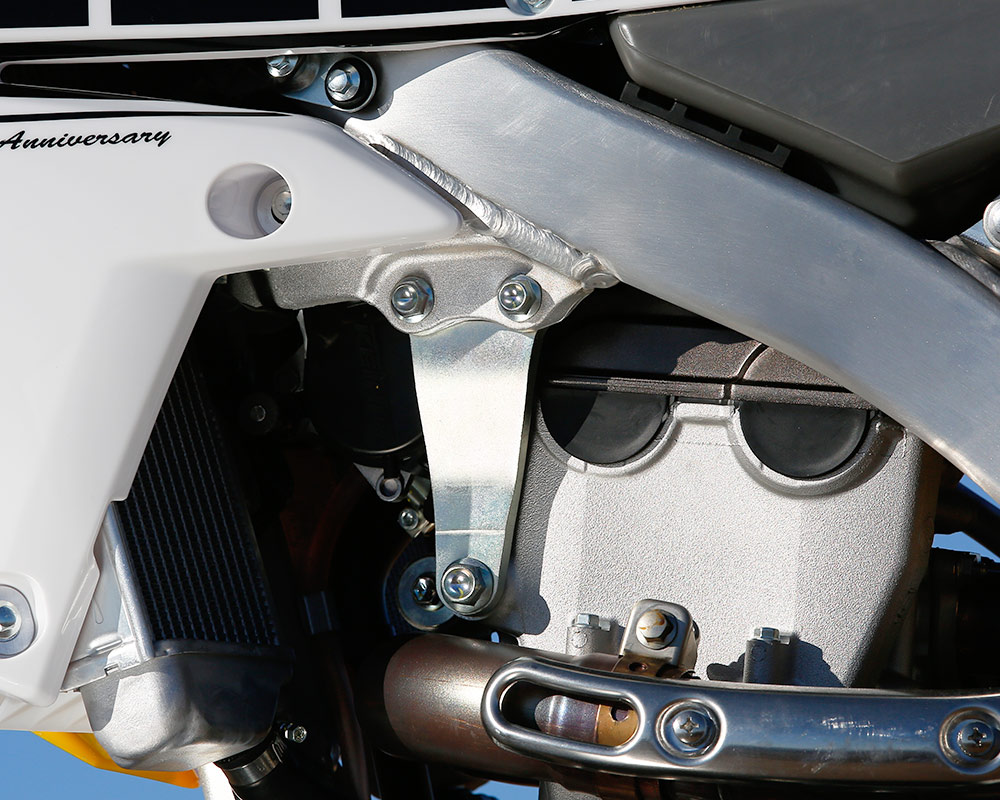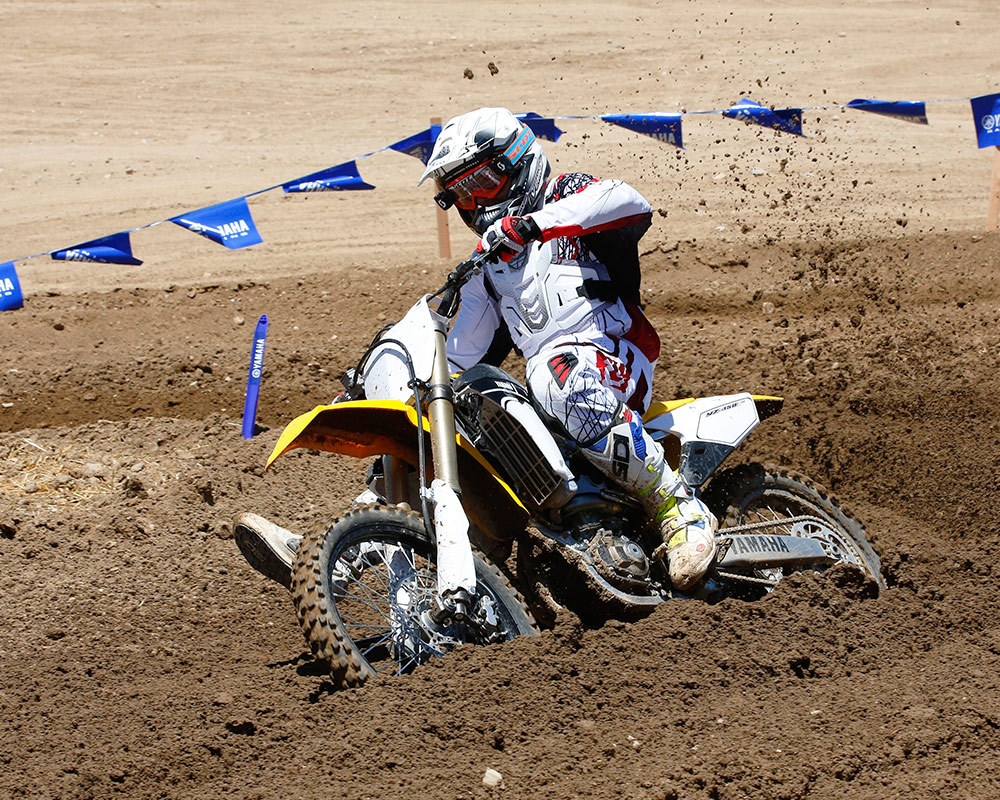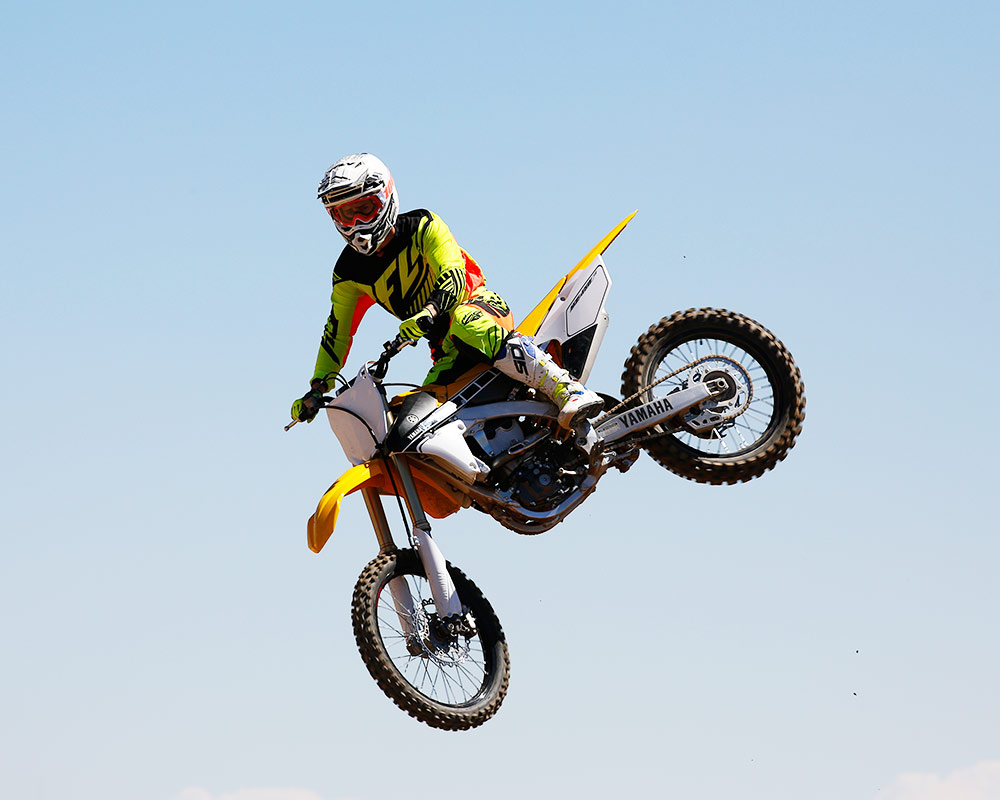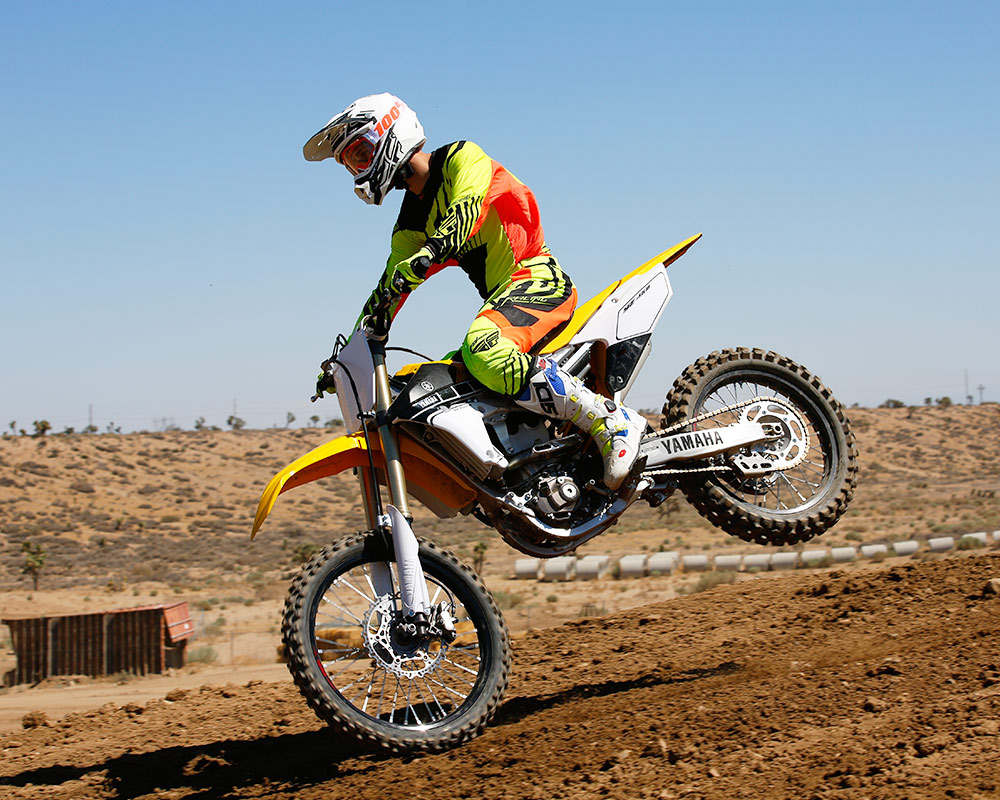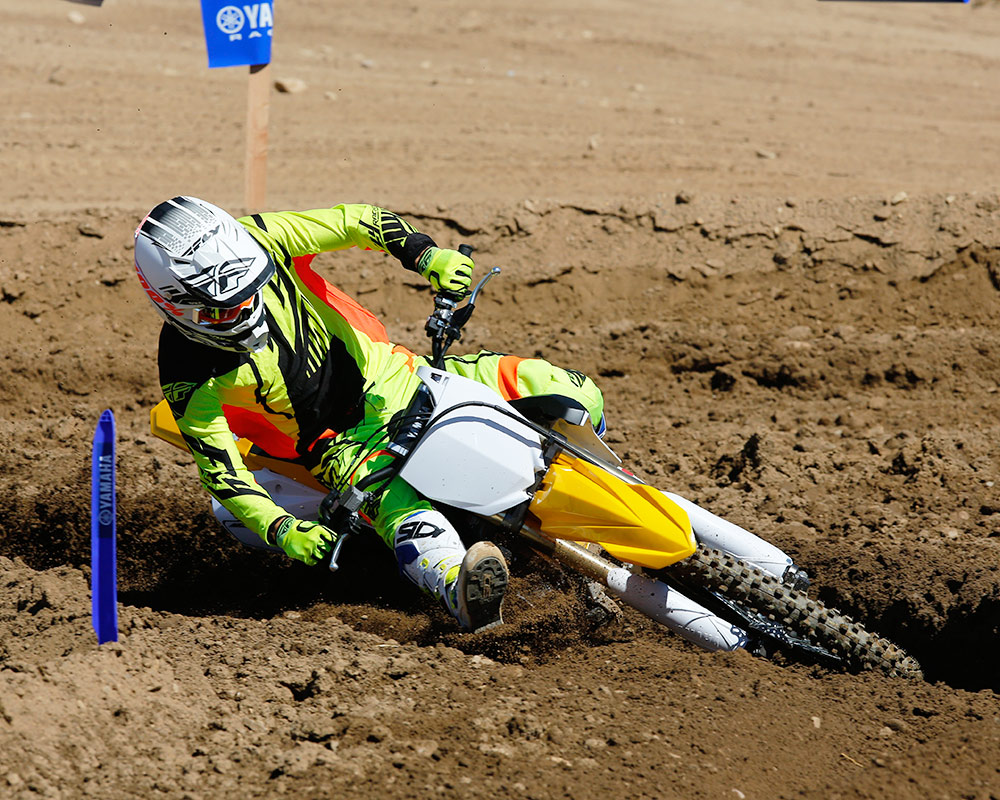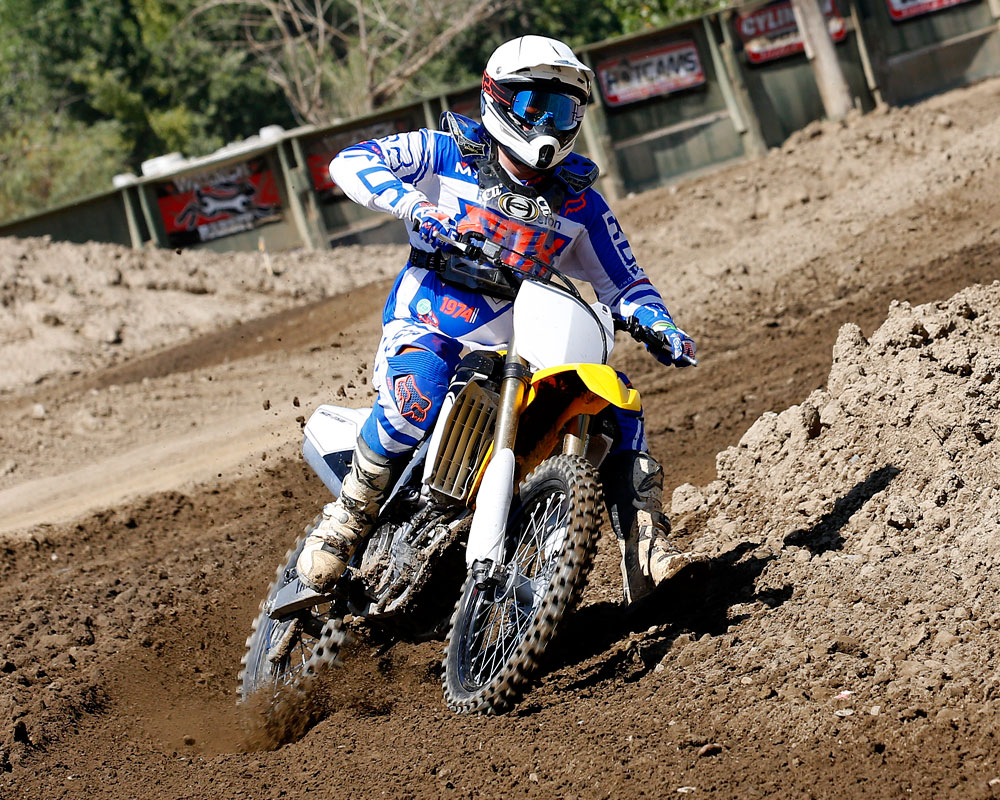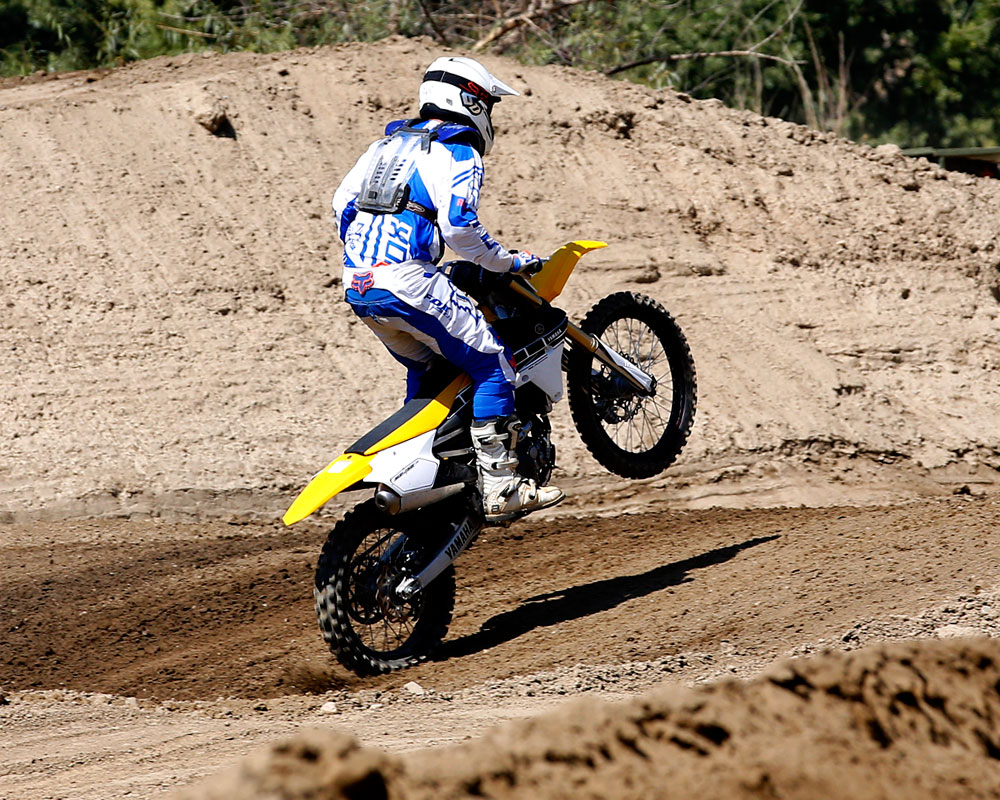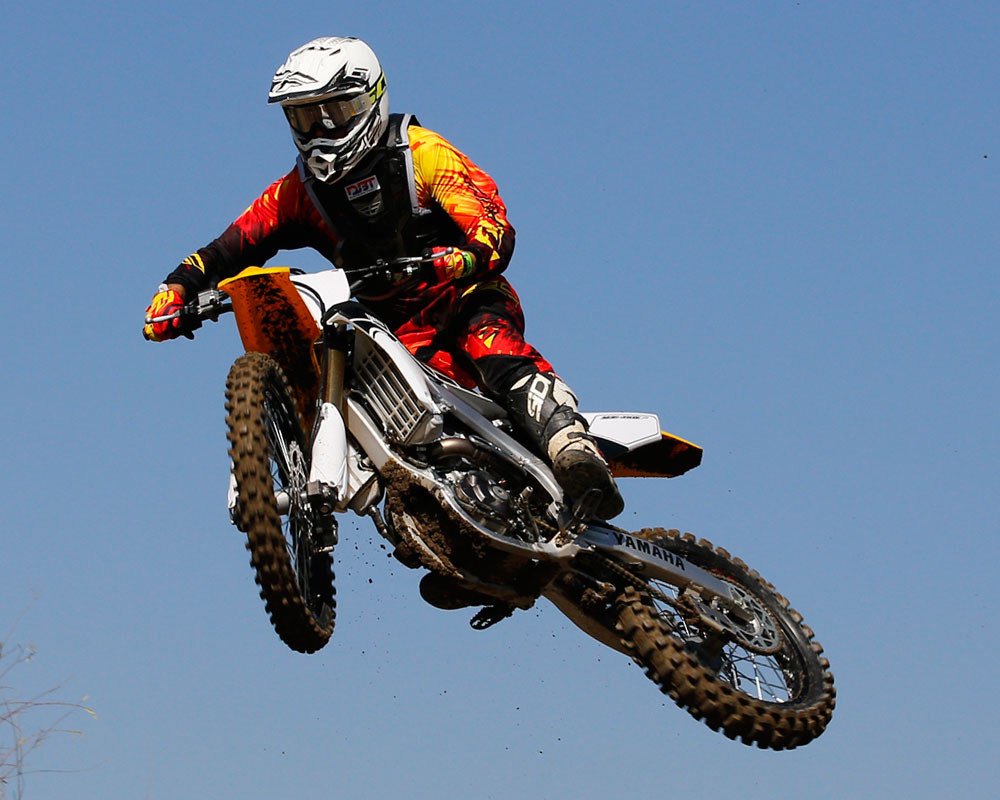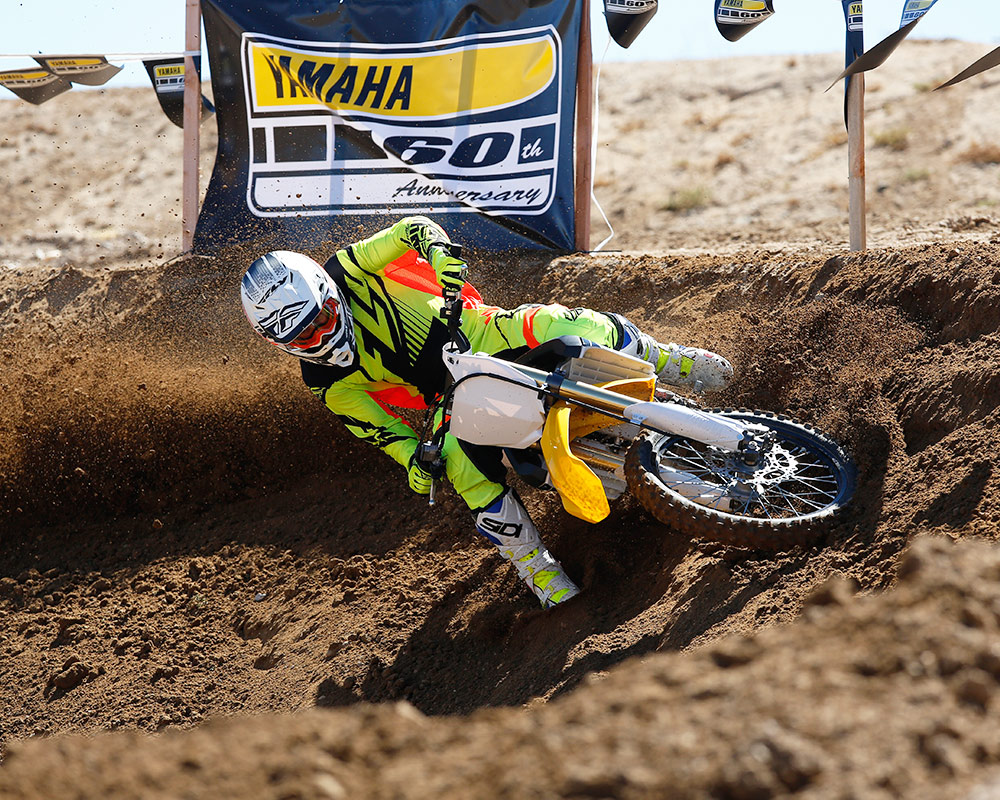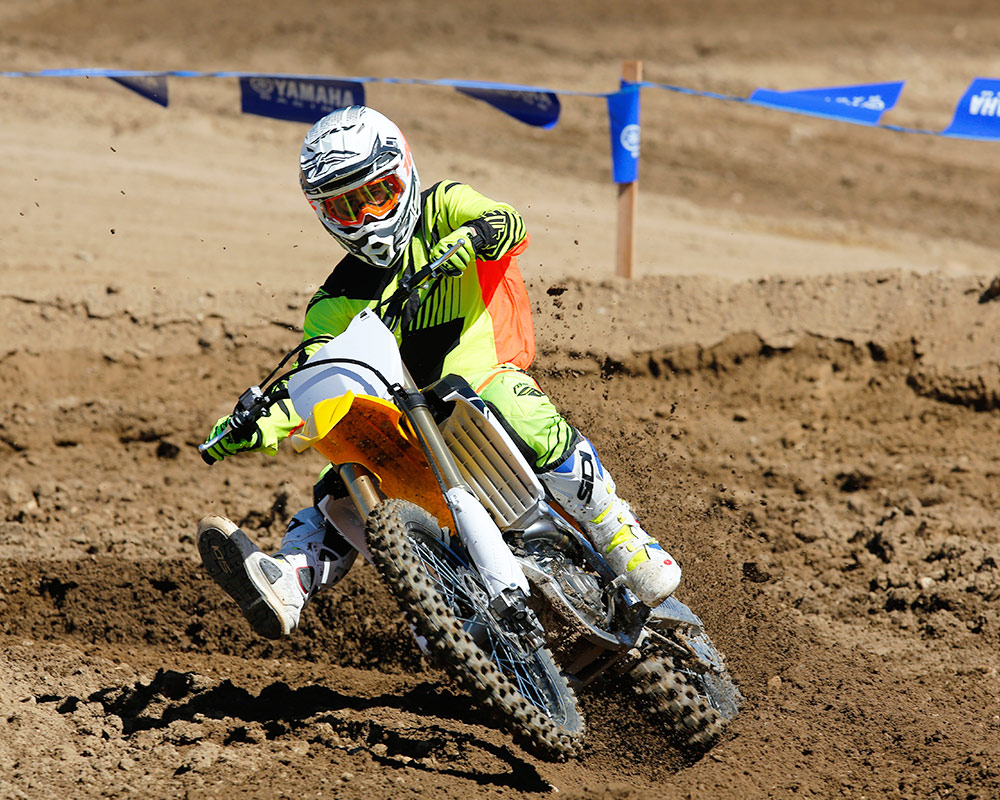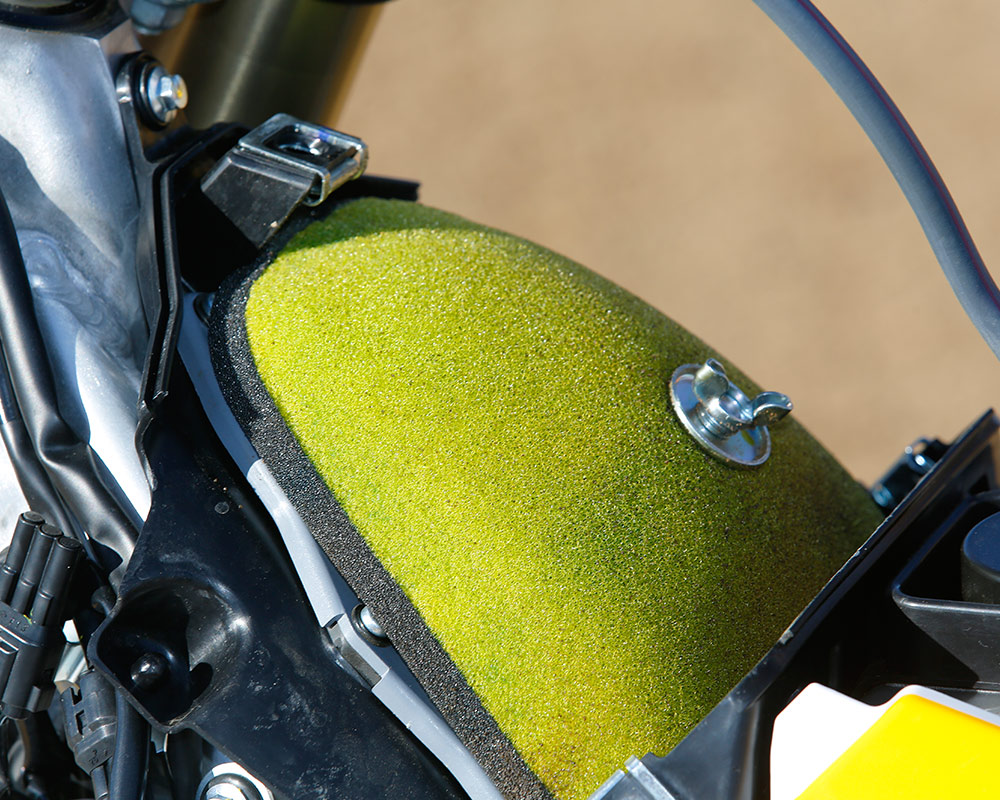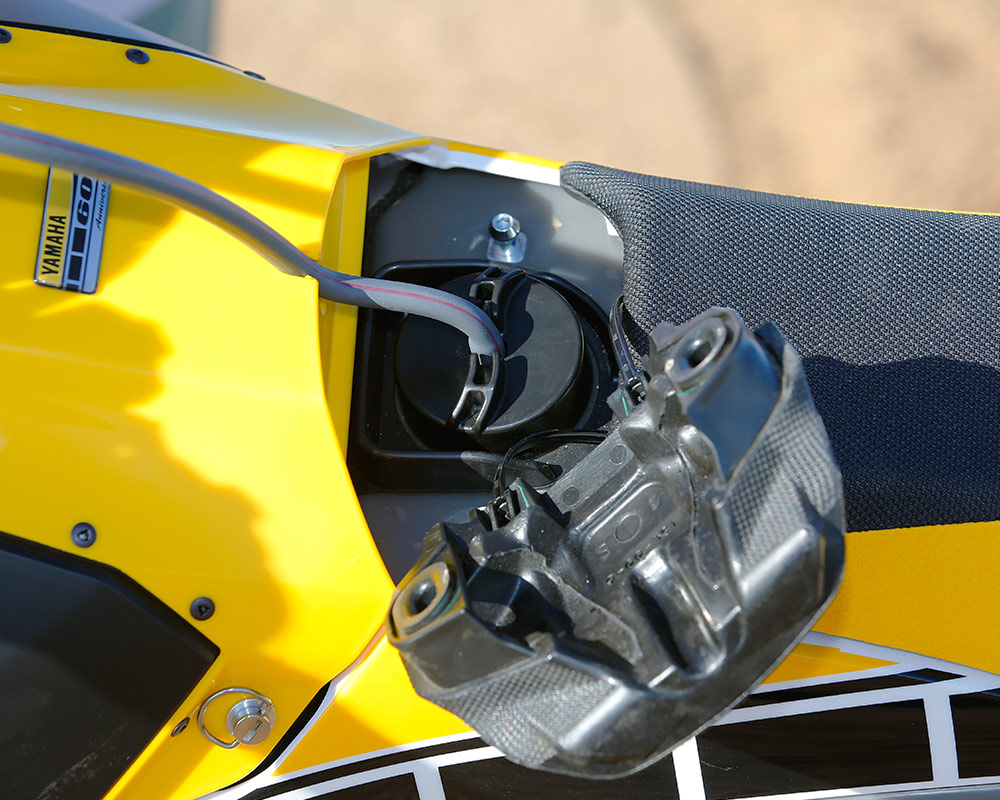2016 Yamaha YZ450F
Getting The Setting Right
MSRP: $8590.00 Blue/$8690.00 Yellow
- Increased stability with a more manageable power delivery to make the YZ450F more appealing to a larger group of riders.
- One of the most tunable and adjustable bikes you can buy.
- Available in Blue or 60th Anniversary Yellow.
- Not as polar with riders as before.
- Every one of our riders tinkered with settings to get happy.
- We feel the standard engine setting could easily be better.
- Our Yellow bike was too pretty to get dirty, but we did it anyways!
Introduction
- Yamaha's refined full-size MX Bike.
- Better handling through frame and triple clamp changes.
- Smoother power and better shifting.
In 2010 Yamaha unleashed what it thought was going to change motocross. The company defied tradition and spun the cylinder head around backwards, intake on the front and exhaust out the rear looking for more power through a straighter intake track and a more mass centralized layout. It worked and it didn’t. The changes put the YZ in a very unique handling department, emphasizing the front-wheel steering (not rear wheel sliding) style of handling and making it a standout in a class that was becoming very homogenized. Some riders loved it but others didn’t. Included in the “others” were high-profile racers who let blame fall on the bike for poor race results. The YZ’d design had a tarnished image at best but Yamaha stuck with it and refined the former design into an all-new bike under the same principal in 2014 which was recognized with more success but still struggled come comparison time. The YZ is just different. For 2016 the changes seem aimed to bring the YZ more towards the center of the motocross handling and power delivery universe but is this the right direction?
Changes
- Larger frame forging at the footpeg area.
- More triple clamp offset.
- New cam profile.
- Softer rear shock spring.
Though the YZ450F looks mostly unchanged from its 2010 introduction with the reversed engine design, it is a completely different bike. The major upgrades for 2015 focused on stiffing the chassis and changing the attitude of the bike through linkage, spring rate and triple clamp offset alterations. On the engine side of things the cam shapes and timing is different and the ECU now has the addition of a launch control map and overall setting changes to increase power and drivability, especially in the lower rev zones.
The frame keeps it’s geometry from the past and adds new stiffer forged footpeg/swingarm pivot area on the aluminum frame. Footpegs are 5mm lower to help lower the rider’s center of gravity too. Additionally the engine mounts are 2mm thicker and of a new shape. These changes tune the flex character of the bike to match what Yamaha likes to call a more balanced ride. There are internal suspension changes but the biggest difference is the reduction of the rear shock spring’s rate (58Nm to 56Nm) and new triple clamps with a 25mm fork offset which strangely keeps the bike with the same trail while altering the rake ever so slightly. It is lower in the rear while trying to keep the same steering feeling. It is a game of adding stability without losing the lighter handling feeling. But maybe the biggest non-change that could help the YZ is the decision to stay with a convention spring fork in its proven SSS KYB units at a time when the media is bashing the competitor’s air-spring forks.
The big change for the engine is the addition of a launch control for the starts. The push-button feature aims to provide a specialized ignition curve to aid in motocross starts and is different than other manufacturers in how it works. There are small changes to the shifting mechanism, clutch boss and a small camshaft profile change to aid in providing what Yamaha calls an optimized power character. Even the water pump impeller received a small change of having holes drilled into it for less cavitation or pressure build up inside the pump.
A larger front brake rotor slows the package down and there is of course the Yellow 60th anniversary addition colorway for the YZ showcasing the companies racing history in the US. The brand still prides itself on the mass centralization on the YZ with its wrap-around header and very tightly packed under-seat gas tank. Since introduction the YZ’s airbox has grown and the fuel capacity has gone up while the engine has shrunk, specifically in 2014 where the oiling system went from a dry-sump to a wet-sump and dropped nearly a quart in total oil capacity.
Power
- Strong and barky motor with snap on the bottom and on the top.
- Highly adjustable with the GYTR Power Tuner.
The 2016 YZ450F has the motor to get the job done. But we also found it was varied in how different riders described it. The YZ fires up about average for a kick-start 450cc. It comes on earlier and has more torque at the lower RPMs with a very sensitive throttle. Response is insanely good, maybe too good for some where it can be abrupt on the bottom end. Into the mid the YZ falls a little flat in comparison to the impressive bottom. Now here is where some explanation is needed. Some riders never ride in the bottom end and will not ever let the motor chug down to that level. So riders who revved the YZ past the bottom felt the mid-range and were a little let down by the pick-up here, yet everyone expressed that the throttle was still very sharp and crisp even if they did not get the pick-up in power they were looking for. On top the YZ makes some serious power and pulls very hard, as hard as any stock 450 will. It can get through its spread a little on the quick side calling for a shift before hitting the rev limiter, but the YZ will rev pretty far before it starts to cut out. Luckily Yamaha has one of the best FI tuning tools GYTR Power Tuner (sold separately $279.95) out there and it is very simple to change the character if you feel the need. We played around with it a lot and every rider had a setting they preferred after testing a few different maps. (Yamaha even has suggested maps available) To get a smoother overall spread we added some fuel everywhere, especially on top as well as retarted the ignition at high RPM and large throttle openings. To boost the bike in the middle for our heavier riders and riders wanting more snap here we added ignition timing almost everywhere and added fuel on the middle and top sections of the curve as well.
Our heavier rider, even after mapping changes, really appreciated adding a tooth to the rear sprocket size. This had the bike picking up a lot easier in the shift between second and third making a world of difference in jump approaches out of turns. For our lighter riders it meant not needing to downshift into second even in some tighter turns. And since the power spread is so wide there wasn't the usual extra shifting that sometimes comes with shorter gearing.
Our bike started out shifting a little stiff but broke in just fine after about 10-hours and a couple of oil changes. The clutch was average and can get hot if you use it a lot but it didn’t actually fade, just the lever position changed and was easily adjusted with the quick-adjust on the assembly.If you can run the lever a little on the lose side the leverage of the pivot can work to your advantage. The exhaust has a nice sound to the rider (a large portion of the noise is actually intake noise coming right from under your chin) and is decently quiet when on the track. The YZ does not have the impression of being corked up but it can let out a nice lean pop on deceleration. Adding a little fuel with the tuner at closed throttle positions will make this go away.
The YZ’s oil capacity may seem like a concern to some but most riders change the oil way before the intended seven hour service life of the one-quart (.95-liter) storage. Yamaha has a very proven record in the durability department and we have no reason to be concerned over this for motocross use.
Then there is the launch control. In testing it has been the same result as we have had with almost every manufacturer's launch control. You have to learn how to use it and when it is an advantage. But out of all of them, this one on the YZ450F seems to do the least in terms of how the bike feels off the line (it feels aggressive) but it also minimized mistakes about 10-feet off the gate again without feeling too muted. You do have to practice with it and learn how to maximize it's potential.
Suspension
- The same components with a softer rear setting.
- The conventional spring fork is comfortable and familiar.
For the past few years most riders were going lower and lower on the ride height from the recommended 100mm way down into the 115mm range to get the stability up and especially to have the bike feeling more confident going into the turns. Since its redesign the YZ has been known as a sharp turner, maybe too much for some especially in a world where the bikes winning the comparisons were less about turning and more about stability. With the softer rear spring the YZ rides a little lower all the time even with a more conventional 100mm suggested ride height for the 2016 YZ. Through valving changes the shock is tuned to work better and in conjunction with the fork give a better balanced ride. First off, for the average weight rider this has worked at getting the YZ more in line with how other bikes feel. But for those heavier on the weight scale it has made the bike less adaptable without the correct spring. Luckily the fork is excellent and does not disappoint. It has the best plushness in any conventional spring fork plus it works like we know and understand with very good bottoming resistance. It seems to use the stroke well and if anything is very active under most conditions.
The YZ rides a little low in the rear and the shock allows the wheel to move a lot and pretty freely. At the same time the bike amazingly has the stroke you need so that it isn’t bottoming or packing much at all. Most riders were able to go a bit stiffer on both the compression and rebound settings and comfort and confidence went up. If there was one area we struggled with was long sweeping jump faces, sort of a mid-speed extended compression where the bike would use too much travel for some of our slower and medium speed riders. Faster riders comments that they felt the bike let them fly low and fast over these jumps.
The fork appreciated the same increase in clicker compression and rebound damping for most riders and in reality no matter what was praised for overall feel. It isn’t as supple on the small bumps as some of the air forks nor does it resist bottoming as well but it is consistent and does not have a spike anywhere in the travel. We moved the forks in the clamps some but we’ll get to that in the handling section where it seems the overall chassis balance has as much to do with the suspension setting and performance as anything. It was more crucial than the clickers for most.
Chassis - Handling
- The changes bring the YZ in line with the more stable bikes in the class.
- The bike does not like to have too much sag.
- The power plays a big part in the handling of the bike, tuning it can drastically change the handling.
If there is an area where the YZ is a love it or hate it bike, it is in the handling. That said we took a little trip to get use to the way the YZ works. Most, after a couple of days and a specific setup, were back in the happy zone. And as much as the suspension on the YZ450F is tied to the chassis setup, so is the motor and it’s setup. As sensitive as it is the throttle can overcome a lot of the handling characteristics, or amplify or negate them. The YZ has proven to us it is a very adjustable bike and maybe to its own fault, as we were playing with everything for each rider and came away with a few different combinations.
The tuning of the chassis, small changes to even the use of thicker engine mounts, all plays into this feel that Yamaha feels is an advantage and we’d have to agree. The more stable ride of the YZ will definitely appeal to a larger group of riders but for some the sharpness of the steering isn’t what it once was and it does not really come back even with changing the setup to putting more weight on the front wheel. This, in our experience, is the lower footpeg positon coming into play. The ride height is critical and using a standard setting in the 100mm range as a starting point is a good plan. Then you decide if you want better turning (tighten up the spring or add high-speed shock compression) or more stability (do the opposite) and fine tune from there. It is pretty simple but takes time and testing. We even had our heavier rider slide the forks up in the clamp 5mm to get to a happy place and the bike really responds. One area we struggled with was higher-speed chop in turns on harder ground but when you have the chassis setup right it is a simple suspension click away from being fixed.
In the air the YZ has a neutral feel. A new feeling for 2016 is the bike can be whipped out in the rear much easier than before. It feels looser than the previous bike when off the ground but it will not challenge the lightest feeling bikes for those that like to get very aggressive in the air. Yet on the ground the YZ acts as one of the lighter feeling bikes in the control a rider has through the footpegs even though the feel through the bars is a little heavier in side-to-side. Turning weight in the bars is light as well so it depends on where a rider feels the weight from on how light or heavy the bike will feel. On our scale the bike was 245 pounds with a full tank of gas with the MX32 tires installed.
Maybe the biggest difference is how the bike transitions onto a rougher track. And here, if your setup is correct is where the biggest difference can be felt. On the older YZ, sometime the bike just told you to slow down when the conditions went from bad to worse. Now there isn’t such a change in the way the bike acts when it is getting beat up from the ground up. And that seems to be the goal and story of chassis changes, they address issues that are not so obvious or apparent. Additionally we found switching to Dunlop's MX32 from the stock MX52 helps the bike stick to the ground better in the choppy bumps as well as finds better traction all around. And this bike craves front wheel traction.
Lacking a gas cap it is easy to get way forward on the YZ and this helps turning but there is also a visual aspect of the bike that tells you it is wide so some feel they can’t get forward as much as they’d like. It seems the smaller riders get along better with the YZ but that did not stop Travis Preston, all 6’2” of him, from ripping around at the intro looking very comfortable all the time, bars even in the standard position. The footpegs affect the handling more than you’ll ever feel them in the rider compartment.
The larger front brake is now commonplace on MX machines and heavier 450s for sure can use the strength and along with that control. The Yamaha has this covered. A Pro-Taper handlebar has a bend that most find comfortable and the top clamp allows four positions for rider preference. One other funny sensation the bike gives is that there is something loose on it--as if a shock linkage bearing is worn. We checked everything and the bike is tight. We feel this is a very friction-free engine that is now more tightly clamped in the chassis and you can feel a different type or frequency of vibration.
Conclusion
- The YZ450F is improved in small little steps from the previous bike if you prefer a more stable ride.
- It is highly tunable, likely the most versatile in character without major modifications.
If anything the Yamaha use to be a more polar bike that stood out in the crowd with a very unique handling character and a very snappy motor. Rider’s quickly and decisively liked it or hated it. This latest version is much less polar but still not the same as other bikes. For some reason it is not the bike any of our riders just jumped on and loved it from the first impression. For us it took some tuning, whether engine or chassis or both to make testers comfortable. Were sure there are those out there that will just hop on the YZ and love it--considering Yamaha settled on the stock setting--they expect this is the case. But regardless the best thing was that we were all able to find a happy place with simple adjustments and every rider felt with time and more familiarity they would be compatibly happy. Recent success in comparison testing seems to back this up but we feel it may also be due to the fact that most of the other bikes have switched to air spring forks and many riders (especially in the enlightened magazine test rider world) are not coming to terms with them just yet. This also proves how good all the choices are these days, the YZ450F right in the mix.
The durability of the YZs has been exceptional in recent history provided you are smart about routine maintenance like the oil and air filter. The filter is tool-less to get at and easy to change. Some complain about the gas cap location below the seat but it isn't that difficult to get at. The hardware on the YZ is quality as well and there is't any signs of corner cutting on any of the pieces. And the ease of using the GYTR Power Tuner and the significant results has to be complimented even if it is a $280 accessory it is the best thing you can have for your YZ450F.
After a lot of testing and for sure we'll be doing some more and adding information about our findings, this YZ450F packs power and potential but we feel you will have to work with it just a little to get the best out of it.
Recent Product Tests
What Others Said

http://www.cycleworld.com/2015/08/06/2016-yamaha-yz450f-first-ride-motocrosser-motorcycle-review-photos-specs-pricing/

http://www.dirtrider.com/2016-yamaha-yz450f-first-ride

http://www.cyclenews.com/431/36213/Racing-Article/First-Ride--2016-Yamaha-YZ450F.aspx

http://motocross.transworld.net/videos/2016-yamaha-yz450f-first-impression/#f2AF6EYhHCD0W8P5.97
Rider Opinions
Leave a Reply
